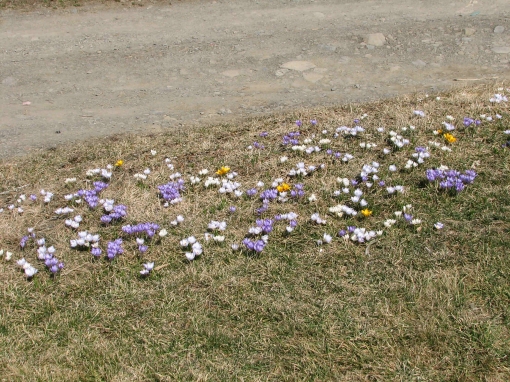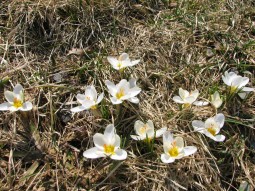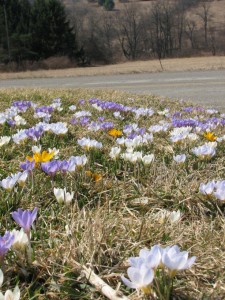
“There ya’ go, lady. All’s ya gotta do is sprinkle some grass seed and you’re all set.” I smiled and thanked the hard-hatted foreman of the highway crew, and then turned to survey the damage. Early that autumn morning the foreman had knocked on my door, informing me that they wanted to regrade our dirt driveway so that it tipped slightly to the south and funneled water into the ditch at the side of the road instead of directly into the road. During the freeze/thaw cycle of mud season, the runoff collected in a puddle in the middle of the road and froze, creating a traffic hazard. I had no desire to see an automobile spin out of control in front of my house, so I readily agreed. Unbeknownst to me, however, they decided to do me a “favor” and regrade the southern bank of the driveway, moderating the slope so it would be easier to mow. I could see that the slope was now much shallower, but I could also see that no grass would grow there without a serious investment of work and money. The topsoil had been completely scraped away, and a few roots from the venerable maple tree growing in that corner of the property poked through. Horticulturally, it was a disaster.
The first thing I did was–nothing. We had just funneled all our financial resources into replacing our completely inadequate septic tank, and there was no money for the kind of soil renovation needed to make seeding grass worthwhile. And with a four-month-old baby plus six other children aged eleven and under to get ready for my sister’s wedding, I didn’t exactly have a lot of spare time in which to tackle the project. I was curious to see what would grow there on its own, and I was hoping the fallen leaves from the maple would make a start on the road back to fertility. I also thought that maybe, just maybe, I didn’t want to grow grass there. It wouldn’t hurt to think it over during the winter.
Can you see me writing to the question-and-answer column of a gardening magazine: “Dear Horticultural Expert, please tell me what plants will grow in clay subsoil. Yours truly, Incredibly Naive.” At least I knew enough to know that I didn’t know much. I read garden books and magazines voraciously while breastfeeding and throughout each winter, hoping to find the magic solution. In the meantime, the weeds grew and the leaves fell in their season, and the mown weeds and the fallen leaves were left in place to enrich the soil.
Finally, an article from the May 1990 issue of Fine Gardening about growing small bulbs in a buffalo grass lawn inspired me. Crocus, it seems, originally grew on the arid steppes of Asia. They expect drought in the summer and they don’t need fertile soil to survive. Well, why not, I thought. I’d certainly felt the need for more spring color, and the White Flower Farm catalog had the most seductive photos. Their prices were rather less seductive, however, and I decided to imitate their blue and white crocus collection by purchasing the bulbs from a more reasonably priced merchant. In 1994 I bought
- 70 Princess Beatrix
- 35 Violet Queen
- 48 Snowbunting (fragrant)
- 30 Queen of the Blues
- 30 Snowstorm
- 45 Striped Beauty
 for a total of 258 bulbs. It sounded like a lot of bulbs to me, and I was sure they would cover the bank, so I dutifully planted them 2 to 3 inches apart, as recommended by yet another bulb catalog. Much to my chagrin, when I was all done only a third of the slope was planted. I had never even attempted calculating the square footage of the area I wanted to cover. Having learned my lesson, I tried to come up with an approximate square footage for the irregularly shaped area, and in 1996 I planted
for a total of 258 bulbs. It sounded like a lot of bulbs to me, and I was sure they would cover the bank, so I dutifully planted them 2 to 3 inches apart, as recommended by yet another bulb catalog. Much to my chagrin, when I was all done only a third of the slope was planted. I had never even attempted calculating the square footage of the area I wanted to cover. Having learned my lesson, I tried to come up with an approximate square footage for the irregularly shaped area, and in 1996 I planted
- 200 mixed crocus
- 50 Bluebird
- 100 Prinses Beatrix
- 100 Miss Vain (fragrant)
- 100 Violet Queen
for a total of 550 more bulbs. This time I also planted 50 bulbs of Tulipa bakeri ‘Lilac Wonder,’ which I thought would also do well and would extend the season. I have to admit, I did kind of fall for the White Flower Farm catalog copy, which described this tulip as looking like “a sweetly pink Crocus that arrived too late to the party.” But, once again, I didn’t buy it from them. I am so cheap (frugal? thrifty?). It was that same character trait which prompted me to buy the mixed color crocuses. Per bulb, they were much less expensive than the named varieties, and I figured I could dig the yellow ones out and replant them elsewhere, and still come out ahead. In the end, I decided to keep them there. The blues and the whites tend to disappear against the background of dormant vegetation, but the little zings of golden yellow grab your attention and focus it on the whole planting.
Planting these little bulbs was definitely a labor of love. I could only plant after a good soaking rain, otherwise the subsoil was impossible to penetrate. I used a sturdy dibble and bore down on it with my weight while rotating it to drill a hole. Ironically, I was delighted to come across small rocks; they actually made the job easier. I would take one of those forked dandelion weeders and pry the rock out, and use the cavity as my planting hole. Once I dropped a corm in, I stuck my thumb in the hole and made a “C” with my thumb and forefinger. Where my index finger landed, that’s where I planted the next one. Six hundred bulbs, one at a time. It did get tedious. What kept me going was not wanting to waste the money I’d spent (frugality rears its ugly head once again), and the memories of cabin fevers past. And, of course, with the second batch, I had the vision of how nice the first 250 flowers looked to urge me on. I also harbored the secret hope that someday a total stranger would pull over on the side of the road and tell me how much they appreciated them.
 If you are familiar with crocus varieties you will know that I planted both the earlier blooming species crocus and the larger but later Dutch crocus. At peak bloom most of both kinds are blooming (this might not be so further south with a longer spring) and the effect is glorious. On a warm day you can catch a tantalizing whiff of the fragrant varieties and the bees are ecstatically buzzing from blossom to blossom. In late afternoon they are backlit by the sun and especially enchanting.
If you are familiar with crocus varieties you will know that I planted both the earlier blooming species crocus and the larger but later Dutch crocus. At peak bloom most of both kinds are blooming (this might not be so further south with a longer spring) and the effect is glorious. On a warm day you can catch a tantalizing whiff of the fragrant varieties and the bees are ecstatically buzzing from blossom to blossom. In late afternoon they are backlit by the sun and especially enchanting.
The crocuses have been a good start, but at this point I don’t feel that the problem of the slope has been solved. It has filled in, on its own, with grass and weeds to point that it resembles the rest of what passes for a lawn in these rural parts. I am at a crossroads: I have to decide if I just want my big display of crocus and then maintain it as part of the lawn, or if I want it planted with something more decorative all the time. Right now I have a foot in both camps, and the results look as ambivalent as I feel. The ‘Lilac Wonders’ are pretty, but they bloom so much later than the crocus that the grass has grown up six inches around them, and you can’t see them when they’re blooming. And then you have to wait for the foliage to die down before you mow. If I’m going to keep them there, I should get rid of all the grass and plant the slope intensively with ornamentals, otherwise it’s going to look unkempt for at least as long as it looks terrific.
On the other hand, I read an article by Brian Bixley (“The Search For a Mowable Ground Cover,” Horticulture May ’99, pp. 64-66) on his approach to taming a difficult-to-mow area. He planted a combination of colchicums with Geranium himalayense and G. endressii. The groundcovering geraniums provided bloom and foliage generous enough to hide the dying colchicum leaves. In late summer he mowed down the geranium foliage so that the display of colchicum blossoms was unobstructed. The geranium foliage grew back as the colchicum flowers died off. I tried sticking some rooted pieces of Geranium sanguineum in a few places on the slope as an experiment. They hung around for one growing season, maybe two, and then disappeared from sight. I am not sure if the lawnmower got them, or drought, or if they just got choked out by the surrounding vegetation. (Bixley killed off all his grass with Roundup before planting his geranium seedlings, but I didn’t have the courage to do that. Also, he has free-draining soil versus my clay subsoil, so I’m not sure what would be the best geranium for my situation.) I had plenty of surplus colchicums on hand, and I interplanted them with autumn flowering Crocus speciosus in one spot. Much to my surprise, the crocuses bloom after the colchicums, but they both looked mighty cheerful in the fall. I love the idea of the whole slope spangled with the lavender-pink colchicum blooms in the fall, but colchicum leaves take even longer to die down in spring than the tulip leaves, so I’m back to the problem of an unmown bank for all of spring and a good part of summer unless I can figure out how to get the geraniums to grow. I’m back to the modus operandi that I started with in the beginning: until I’m certain what I want to do, I’ll do nothing. Except, of course, to enjoy the crocuses this spring.
Originally published in Upstate Gardeners’ Journal Vol. 10, Issue 5 (November/December 2004) pp. 16-17




Recent Comments